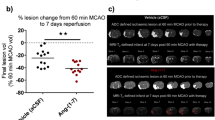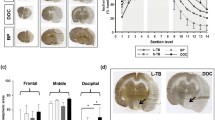Abstract
Remote ischemic conditioning (RIC) has attracted much attention as a protective strategy for the heart and brain, although the underlying mechanisms remain unclear. We hypothesized that RIC enhances collateral circulation during cerebral ischemia through endothelial function and mitigates both early ischemic change and final infarct volume. We tested the RIC and sham procedure 30 min after permanent middle cerebral artery occlusion (MCAO) in male mice. Collateral circulation was examined during the procedure with 2D color-coded ultrasound imaging. Immediately after four cycles of RIC, early ischemic lesions on magnetic resonance imaging (MRI), diffusion-weighted imaging (DWI), and development of pial collateral vessels were examined. The neurological signs and infarct volume with TTC were examined until 48 h after daily RIC. As compared with sham procedure, RIC enhanced collateral circulation, diminished early ischemic lesions, enlarged pial collaterals, and mitigated infarct volume. Next, we examined the effect of inhibitor of nitric oxide synthase (NOS) and Akt on the beneficial effect of RIC in MCAO. Both allosteric Akt inhibitor, 8-[4-(1-Aminocyclobutyl)phenyl]-9-phenyl[1,2,4]triazolo[3,4-f][1,6]naphthyridin-3(2H)-one (MK2206), and two NOS inhibitors, N5-(1-Iminoethyl)-L-ornithine dihydrochloride (L-NIO) and NG-Nitro-L-arginine methyl ester hydrochloride (L-NAME), counteracted the beneficial effect of RIC on collateral circulation, early lesions, pial anastomosis, and infarct volume. In permanent MCAO, RIC could enhance collateral circulation through leptomeningeal anastomosis with Akt-eNOS pathway and diminish early lesion and final infarct volume.








Similar content being viewed by others
Data Availability
Not applicable.
Code Availability
Not applicable.
References
Hess DC, Blauenfeldt RA, Andersen G, Hougaard KD, Hoda MN, Ding Y, et al. Remote ischaemic conditioning-a new paradigm of self-protection in the brain. Nat Rev Neurol. 2015;11:698–710. https://doi.org/10.1038/nrneurol.2015.223.
Bøtker HE, Kharbanda R, Schmidt MR, Bøttcher M, Kaltoft AK, Terkelsen CJ, et al. Remote ischaemic conditioning before hospital admission, as a complement to angioplasty, and effect on myocardial salvage in patients with acute myocardial infarction: a randomised trial. Lancet. 2010;375:727–34. https://doi.org/10.1016/S0140-6736(09)62001-8.
Stiermaier T, Jensen JO, Rommel KP, de Waha-Thiele S, Fuernau G, Desch S, et al. Combined intrahospital remote ischemic perconditioning and postconditioning improves clinical outcome in st-elevation myocardial infarction. Circ Res. 2019;124:1482–91. https://doi.org/10.1161/CIRCRESAHA.118.314500.
Thielmann M, Kottenberg E, Kleinbongard P, Wendt D, Gedik N, Pasa S, et al. Cardioprotective and prognostic effects of remote ischaemic preconditioning in patients undergoing coronary artery bypass surgery: a single-centre randomised, double-blind, controlled trial. Lancet. 2013;382:597–604. https://doi.org/10.1016/S0140-6736(13)61450-6.
Hausenloy DJ, Candilio L, Evans R, Ariti C, Jenkins DP, Kolvekar S, et al. Remote ischemic preconditioning and outcomes of cardiac surgery. N Engl J Med. 2015;373:1408–17. https://doi.org/10.1056/NEJMoa1413534.
Ren C, Gao X, Steinberg GK, Zhao H. Limb remote-preconditioning protects against focal ischemia in rats and contradicts the dogma of therapeutic time windows for preconditioning. Neurosci. 2008;151:1099–103. https://doi.org/10.1016/j.neuroscience.
Ripley AJ, Jeffers MS, McDonald MW, Montroy J, Dykes A, Fergusson DA, et al. Neuroprotection by remote ischemic conditioning in rodent models of focal ischemia: a systematic review and meta-analysis. Transl Stroke Res. 2021;12(3):461–73. https://doi.org/10.1007/s12975-020-00882-1.
Hougaard KD, Hjort N, Zeidler D, Sørensen L, Nørgaard A, Hansen TM, et al. Remote ischemic perconditioning as an adjunct therapy to thrombolysis in patients with acute ischemic stroke: a randomized trial. Stroke. 2014;45:159–67. https://doi.org/10.1161/STROKEAHA.113.001346.
England TJ, Hedstrom A, O’Sullivan S, Donnelly R, Barrett DA, Sarmad S, et al. Recast (remote ischemic conditioning after stroke trial): a pilot randomized placebo controlled phase ii trial in acute ischemic stroke. Stroke. 2017;48:1412–5. https://doi.org/10.1161/STROKEAHA.116.016429.
England TJ, Hedstrom A, O’Sullivan SE, Woodhouse L, Jackson B, Sprigg N, et al. Remote ischemic conditioning after stroke trial 2: a phase iib randomized controlled trial in hyperacute stroke. J Am Heart Assoc. 2019;8:e013572. https://doi.org/10.1161/JAHA.119.013572.
Pico F, Lapergue B, Ferrigno M, Rosso C, Meseguer E, Chadenat ML, et al. Effect of in-hospital remote ischemic perconditioning on brain infarction growth and clinical outcomes in patients with acute ischemic stroke: the rescue brain randomized clinical trial. JAMA Neurol. 2020;77:725–34. https://doi.org/10.1001/jamaneurol.2020.0326.
An JQ, Cheng YW, Guo YC, Wei M, Gong MJ, Tang YL, et al. Safety and efficacy of remote ischemic postconditioning after thrombolysis in patients with stroke. Neurol. 2020;95:e3355–63. https://doi.org/10.1212/WNL.0000000000010884.
Chen HS, Cui Y, Li XQ, Wang XH, Ma YT, Zhao Y, et al. Effect of remote ischemic conditioning vs usual care on neurologic function in patients with acute moderate ischemic stroke: the RICAMIS randomized clinical trial. JAMA. 2022;328(7):627–36. https://doi.org/10.1001/jama.2022.13123.
Shuaib A, Butcher K, Mohammad AA, Saqqur M, Liebeskind DS. Collateral blood vessels in acute ischaemic stroke: a potential therapeutic target. Lancet Neurol. 2011;10:909–21. https://doi.org/10.1016/S1474-4422(11)70195-8.
Seifert K, Heit JJ. Collateral blood flow and ischemic core growth. Transl Stroke Res. 2022. https://doi.org/10.1007/s12975-022-01051-2.
Bonnin P, Kubis N, Charriaut-Marlangue C. Collateral supply in preclinical cerebral stroke models. Transl Stroke Res. 2022;13(4):512–27. https://doi.org/10.1007/s12975-021-00969-3.
Todo K, Kitagawa K, Sasaki T, Omura-Matsuoka E, Terasaki Y, Oyama N, et al. Granulocyte-macrophage colony-stimulating factor enhances leptomeningeal collateral growth induced by common carotid artery occlusion. Stroke. 2008;39:1875–82. https://doi.org/10.1161/STROKEAHA.107.503433.
Saito M, Ishizuka K, Hoshino T, Toi S, Kitagawa K. Leptomeningeal anastomosis and early ischemic lesions on diffusion-weighted imaging in male murine focal cerebral ischemia. J Neurosci Res. 2019;97:752–9. https://doi.org/10.1002/jnr.24403.
Omura-Matsuoka E, Yagita Y, Sasaki T, Terasaki Y, Oyama N, Sugiyama Y, et al. Hypertension impairs leptomeningeal collateral growth after common carotid artery occlusion: restoration by antihypertensive treatment. J Neurosci Res. 2011;89:108–16. https://doi.org/10.1002/jnr.22522.
Shuaib A, Bornstein NM, Diener HC, Dillon W, Fisher M, Hammer MD, et al. Partial aortic occlusion for cerebral perfusion augmentation: safety and efficacy of neuroflo in acute ischemic stroke trial. Stroke. 2011;42:1680–90. https://doi.org/10.1161/STROKEAHA.110.609933.17.
Bornstein NM, Saver JL, Diener HC, Gorelick PB, Shuaib A, Solberg Y, et al. An injectable implant to stimulate the sphenopalatine ganglion for treatment of acute ischaemic stroke up to 24 h from onset (impact-24b): an international, randomised, double-blind, sham-controlled, pivotal trial. Lancet. 2019;394:219–29. https://doi.org/10.1016/S0140-6736(19)31192-4.
Ma J, Ma Y, Dong B, Bandet MV, Shuaib A, Winship IR. Prevention of the collapse of pial collaterals by remote ischemic perconditioning during acute ischemic stroke. J Cereb Blood Flow Metab. 2017;37:3001–14. https://doi.org/10.1177/0271678X16680636.
Zhang Y, Ma L, Ren C, Liu K, Tian X, Wu D, et al. Immediate remote ischemic postconditioning reduces cerebral damage in ischemic stroke mice by enhancing leptomeningeal collateral circulation. J Cell Physiol. 2019;234:12637–45. https://doi.org/10.1002/jcp.27858.
Kitagawa K, Saitoh M, Ishizuka K, Shimizu S. Remote limb ischemic conditioning during cerebral ischemia reduces infarct size through enhanced collateral circulation in murine focal cerebral ischemia. J Stroke Cerebrovasc Dis. 2018;27:831–8. https://doi.org/10.1016/j.jstrokecerebrovasdis.2017.09.068.
Hahn CD, Manlhiot C, Schmidt MR, Nielsen TT, Redington AN. Remote ischemic per-conditioning: a novel therapy for acute stroke? Stroke. 2011;42:2960–2. https://doi.org/10.1161/STROKEAHA.111.622340.
Chen J, Sanberg PR, Li Y, Wang L, Lu M, Willing AE, Sanchez-Ramos J, Chopp M. Intravenous administration of human umbilical cord blood reduces behavioral deficits after stroke in rats. Stroke. 2001;32(11):2682–8. https://doi.org/10.1161/hs1101.098367.
Hoda MN, Siddiqui S, Herberg S, Periyasamy-Thandavan S, Bhatia K, Hafez SS, et al. Remote ischemic perconditioning is effective alone and in combination with intravenous tissue-type plasminogen activator in murine model of embolic stroke. Stroke. 2012;43:2794–9. https://doi.org/10.1161/STROKEAHA.112.660373.
Yang J, Balkaya M, Beltran C, Heo JH, Cho S. Remote postischemic conditioning promotes stroke recovery by shifting circulating monocytes to ccr2(+) proinflammatory subset. J Neurosci. 2019;39:7778–89. https://doi.org/10.1523/JNEUROSCI.2699-18.2019.
Leng X, Lan L, Liu L, Leung TW, Wong KS. Good collateral circulation predicts favorable outcomes in intravenous thrombolysis: a systematic review and meta-analysis. Eur J Neurol. 2016;23:1738–49. https://doi.org/10.1111/ene.13111.
Piedade GS, Schirmer CM, Goren O, Zhang H, Aghajanian A, Faber JE, et al. Cerebral collateral circulation: a review in the context of ischemic stroke and mechanical thrombectomy. World Neurosurg. 2019;122:33–42. https://doi.org/10.1016/j.wneu.2018.10.066.
Okyere B, Mills WA 3rd, Wang X, Chen M, Chen J, Hazy A, et al. Epha4/tie2 crosstalk regulates leptomeningeal collateral remodeling following ischemic stroke. J Clin Invest. 2020;130:1024–35. https://doi.org/10.1172/JCI131493.
Nitzsche A, Poittevin M, Benarab A, Bonnin P, Faraco G, Uchida H, et al. Endothelial S1P1 signaling counteracts infarct expansion in ischemic stroke. Circ Res. 2021;128(3):363–82. https://doi.org/10.1161/CIRCRESAHA.120.316711.
Rassaf T, Totzeck M, Hendgen-Cotta UB, Shiva S, Heusch G, Kelm M. Circulating nitrite contributes to cardioprotection by remote ischemic preconditioning. Circ Res. 2014;114:1601–10. https://doi.org/10.1161/CIRCRESAHA.114.303822.
Abu-Amara M, Yang SY, Quaglia A, Rowley P, Fuller B, Seifalian A, et al. Role of endothelial nitric oxide synthase in remote ischemic preconditioning of the mouse liver. Liver Transpl. 2011;17:610–9. https://doi.org/10.1002/lt.22272.
Jung H, Choi EK, Baek SI, Cho C, Jin Y, Kwak KH, et al. The effect of nitric oxide on remote ischemic preconditioning in renal ischemia reperfusion injury in rats. Dose Response. 2019;17:1559325819853651. https://doi.org/10.1002/lt.22272.
Yukami T, Yagita Y, Sugiyama Y, Oyama N, Watanabe A, Sasaki T, et al. Chronic elevation of tumor necrosis factor-α mediates the impairment of leptomeningeal arteriogenesis in db/db mice. Stroke. 2015;46:1657–63. https://doi.org/10.1161/STROKEAHA.114.008062.
Sullender CT, Richards LM, He F, Luan L, Dunn AK. Dynamics of isoflurane-induced vasodilation and blood flow of cerebral vasculature revealed by multi-exposure speckle imaging. J Neurosci Methods. 2022;366:109434. https://doi.org/10.1016/j.jneumeth.2021.109434.
Acknowledgements
This study was in part supported by Institute of Laboratory Animals (ILA) and Medical Research Institute (MRI), Tokyo Women’s Medical University.
Funding
This study is supported by grant-in-aid B (15H04844) and grant-in-aid C (23390234) from the Ministry of Education, Science, and Culture in Japan and the 38th Mihara Cerebrovascular Disorders Research Promotion Fund (2019).
Author information
Authors and Affiliations
Contributions
MS, TH, KI, SI, and ST performed experiments. MS and KK analyzed the data. MS and KK designed the experiment. KK, MS, and NS wrote the paper.
Corresponding author
Ethics declarations
Ethics Approval
The experimental protocols were approved by the Institutional Animal Care and Use Committee of Tokyo Women’s Medical University. This work complies with the Animal Research Reporting In Vivo Experiments (ARRIVE) guidelines.
Conflict of Interest
The authors declare no competing interests.
Additional information
Publisher's Note
Springer Nature remains neutral with regard to jurisdictional claims in published maps and institutional affiliations.
Supplementary Information
Below is the link to the electronic supplementary material.
Supplementary movie 1 (MP4 48.1 MB)
Supplementary movie 2 (MP4 49.2 MB)
Rights and permissions
Springer Nature or its licensor (e.g. a society or other partner) holds exclusive rights to this article under a publishing agreement with the author(s) or other rightsholder(s); author self-archiving of the accepted manuscript version of this article is solely governed by the terms of such publishing agreement and applicable law.
About this article
Cite this article
Saito, M., Hoshino, T., Ishizuka, K. et al. Remote Ischemic Conditioning Enhances Collateral Circulation Through Leptomeningeal Anastomosis and Diminishes Early Ischemic Lesions and Infarct Volume in Middle Cerebral Artery Occlusion. Transl. Stroke Res. 15, 41–52 (2024). https://doi.org/10.1007/s12975-022-01108-2
Received:
Revised:
Accepted:
Published:
Issue Date:
DOI: https://doi.org/10.1007/s12975-022-01108-2




